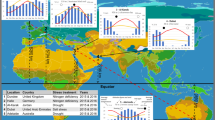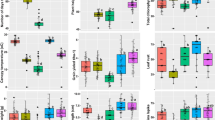Abstract
The projected future climate will affect the global agricultural production negatively, however, to keep abreast of the expected increase in global population, the agricultural production must increase. Therefore, to safeguard the future crop yield and quality, the adaptive potential of crops to environmental change needs to be explored in order to select the most productive genotypes. Presently, it is unknown whether cereal crops like spring barley can adapt to climate stressors over relatively few generations. To evaluate if strong selection pressures could change the performance of barley to environmental stress, we conducted a selection experiment over five plant generations (G0–G4) in three scenarios, where atmospheric [CO2] and temperature were increased as single factors and in combination. The treatments represented the expected environmental characteristics in Northern Europe around year 2075 [700 ppm CO2, 22/17 °C (day/night)] as well as a control mimicking present day conditions (390 ppm CO2, 19/12 °C). Two different barley accessions, a modern cultivar and an old landrace, were evaluated in terms of yield and biomass production. In all treatments representing future environmental scenarios, the G4-generation of selected plants did not improve its reproductive output compared to the G0-generation, as G4 produced less seeds and had a lower yield than unselected plants. These results indicate that barley might not respond positively to rapid and strong selection by elevated [CO2] and temperature, contrary to previous results from oilseed rape. The two barley accessions analyzed presented almost the same response pattern in a given treatment, though the modern cultivar had the highest yield in the climate scenarios, while the landrace was superior in yield under present day climate conditions.


Similar content being viewed by others
References
Altenbach SB, Dupont FM, Kothari KM, Chan R, Johnson EL, Lieu D (2003) Temperature, water and fertilizer influence the timing of key events during grain development in a US spring wheat. J Cereal Sci 37:9–20. doi:10.1006/jcrs.2002.0483
Amthor JS (2001) Effects of atmospheric CO2 concentration on wheat yield: review of results from experiments using various approaches to control CO2 concentration. Field Crop Res 73:1–34
Anderson JT, Willis JH, Mitchell-Olds T (2011) Evolutionary genetics of plant adaptation. Trends Genet 27:258–266
Araus JL, Slafer GA, Royo C, Serret MD (2008) Breeding for yield potential and stress adaptation in cereals. Crit Rev in Plant Sci 27:377–412
Barnabas B, Jager K, Feher A (2008) The effect of drought and heat stress on reproductive processes in cereals. Plant Cell Environ 31:11–38. doi:10.1111/j.1365-3040.2007.01727.x
Brantestam AK, von Bothmer R, Dayteg C, Rashal I, Tuvesson S, Weibull J (2007) Genetic diversity changes and relationships in spring barley (Hordeum vulgare L.) germplasm of Nordic and Baltic areas as shown by SSR markers. Genet Resour Crop Evol 54:749–758. doi:10.1007/s10722-006-9159-4
Ceccarelli S, Grando S, Maatougui M, Michael M, Slash M, Haghparast R, Rahmanian M, Taheri A, Al-Yassin A, Benbelkacem A, Labdi M, Mimoun H, Nachit M (2010) Plant breeding and climate changes. J Agric Sci 148:627–637. doi:10.1017/S0021859610000651
Chauhan S, Khandelwal RS, Prabhu KV, Sinha SK, Khanna-Chopra R (2005) Evaluation of usefulness of daily mean temperature studies on impact of climate change. J Agron Crop Sci 191:88–94. doi:10.1111/j.1439-037X.2004.00122.x
Clausen SK, Frenck G, Linden LG, Mikkelsen TN, Lunde C, Jørgensen RB (2011) Effects of single and multifactor treatments with elevated temperature, CO2 and ozone on oilseed rape and barley. Eur J Agron 10:73–79. doi:10.1111/j.1439-037X.2011.00478.x
Elke M, Kilianb J, Harterb K, Janssonc C, Wankeb D, Sundberga E (2011) Transcriptome analysis of high-temperature stress in developing barley caryopses: early stress responses and effects on storage compound biosynthesis. Mol Plant 4:97–115
Ellis RP, Forster BP, Robinson D, Handley LL, Gordon DC, Russell JR, Powell W (2000) Wild barley: a source of genes for crop improvement in 21st century. J Exp Bot 51:9–17. doi:10.1093/jexbot/51.342.9
Fangmeier A, Chrost B, Högy P, Krupinska K (2000) CO2 enrichment enhances flag leaf senescence in barley due to greater grain nitrogen sink capacity. Environ Exp Bot 44:151–164
FAO (2009) How to feed the world in 2050. http://www.fao.org/fileadmin/templates/wsfs/docs/expert_paper/How_to_Feed_the_World_in_2050.pdf
Frenck G, van Linden L, Mikkelsen TN, Brix H, Jørgensen RB (2011) Increased [CO2] does not compensate for negative effects on yield caused by higher temperature and [O3] in Brassica napus L. Eur J Agron 35:127–134. doi:10.1016/j.eja.2011.05.004
Frenck G, Linden L, Mikkelsen TN, Brix H, Jørgensen RB (2013). Response to multi-generational selection under elevated [CO2] in two temperature regimes suggests enhanced carbon assimilation and increased reproductive output in Brassica napus L. Ecol Evol 3:1163–1172. doi:10.1002/ece3.523
Hakala K, Jauhiainen L, Himanen SJ, Rötter R, Salo T, Kahiluoto H (2012) Sensitivity of barley varieties to weather in Finland. J Agric Sci 150:145–160. doi:10.1017/S0021859611000694
Hatfield JL, Boote KJ, Kimball BA, Ziska LH, Izaurralde RC, Ort D, Thomson AM, Wolfe D (2011) Climate impacts on agriculture: implications for crop production. Agron J 103:351–370. doi:10.2134/agronj2010.0303
IPCC (2007) Climate change 2007: the physical science basis. In: Solomon S, Qin D, Manning M, Marquis M, Averyt K, Tignor MMB, Miller HL, Chen Z (eds) Contribution of working group I to the third assessment report of the intergovernmental panel on climate change. Cambridge University Press, Cambridge, pp 749–843
Jablonski LM, Wang XZ, Curtis PS (2002) Plant reproduction under elevated CO2 conditions: a meta-analysis of reports on 79 crop and wild species. New Phytol 156:9–26. doi:10.1046/j.1469-8137.2002.00494.x
Jaggard KW, Qi A, Ober ES (2010) Possible changes to arable crop yields by 2050. Phil Trans R Soc B 365:2835–2851. doi:10.1098/rstb.2010.0153
Johannessen MM, Mikkelsen TN, Jørgensen RB (2002) CO2 exploitation and genetic diversity in winter cultivars of oilseed rape (Brassica napus); cultivars of tomorrow. Euphytica 128:75–86
Johannessen MM, Mikkelsen TN, Nersting LG, Gullord M, von Bothmer R, Jorgensen RB (2005) Effects of increased atmospheric CO2 on varieties of oat. Plant Breed 124:253–256. doi:10.1111/j.1439-0523.2005.01096.x
Jump AS, Peñuelas J (2005) Running to stand still: adaptation and the response of plants to rapid climate change. Ecol Lett 8:1010–1020. doi:10.1111/j.1461-0248.2005.00796.x
Kraakman ATW, Niks RE, Van den Berg PMMM, Stam P, Van Eeuwijk FA (2004) Linkage disequilibrium mapping of yield and yield stability in modern spring barley cultivars. Genetics 168:435–446. doi:10.1534/genetics.104.026831
Leakey ADB, Lau JA (2012) Evolutionary context for understanding and manipulating plant responses to past, present and future atmospheric [CO2]. Phil Trans R Soc B 367:613–629. doi:10.1098/rsth.2011.0248
Lobell DB, Field CB (2007) Global scale climate—crop yield relationships and the impacts of recent warming. Environ Res Lett 2:014002. doi:10.1088/1748-9326/2/1/014002
Long SP, Ainsworth EA, Leakey ADB, Nösberger J, Ort RD (2006a) Food for thought: lower-than-expected crop yield stimulation with rising CO2 concentrations. Science 312:1918–1921. doi:10.1126/science.1114722
Long SP, Zhu XG, Naidu SL, Ort DR (2006b) Can improvement in photosynthesis increase crop yields? Plant Cell Environ 29:315–330. doi:10.1111/j.1365-3040.2005.01493.x
Luo Q, Bellotti W, Williams M, Wang E (2009) Adaptation to climate change of wheat growing in South Australia: analysis of management and breeding strategies. Agric Ecosyst Environ 129:261–267. doi:10.1016/j.agee.2008.09.010
Makino A (2011) Photosynthesis, grain yield, and nitrogen utilization in rice and wheat. Plant Physiol 155:125–129. doi:10.1104/pp.110.165076
Manderscheid R, Weigel HJ (1997) Photosynthetic and growth responses of old and modern spring wheat cultivars to atmospheric CO2 enrichment. Agric Ecosyst Environ 64:65–73
Manderscheid R, Weigel J (2006) Responses of cereals and sugar beet in a crop rotation to free air carbon dioxide enrichment. Bibliotheca Fragm Agron 11:309–310
Martín-Olmedo P, Rees RM, Grace J (2002) The influence of plants grown under elevated CO2 and N fertilization on soil nitrogen dynamics. Glob Change Biol 8:643–657. doi:10.1046/j.1365-2486.2002.00499.x
Nevo E, Fub Y-B, Pavliceka T, Khalifaa S, Tavasia M, Beilesa A (2012) Evolution of wild cereals during 28 years of global warming in Israel. Proc Natl Acad Sci USA 109:3412–3415. doi:10.1073/pnas.1121411109
Newton AC, Akar T, Baresel JP, Bebeli PJ, Bettencourt E, Bladenopoulos KV, Czembor JH, Fasoula DA, Katsiotis A, Koutis K, Koutsika-Sotiriou M, Kovacs G, Larsson H, Pinheiro de Carvalho MAA, Rubiales D, Russell J, Dos Santos TMM, Vaz Patto MC (2010) Cereal landraces for sustainable agriculture. A review. Agron Sustain Dev 30:237–269. doi:10.1051/agro/2009032
OECD-FAO Agricultural Outlook (2012) doi:10.1787/agr_outlook-2012-en
Prasad PVV, Boote KJ, Allen LH, Thomas JMG (2002) Effects of elevated temperature and carbon dioxide on seed-set and yield of kidney bean (Phaseolus vulgaris L.). Glob Change Biol 8:710–721. doi:10.1046/j.1365-2486.2002.00508.x
Pswarayi A, van Eeuwijk FA, Ceccarelli S, Grando S, Comadran J, Russell JR, Pecchioni N, Tondelli A, Akar T, Al-Yassin A, Benbelkacem A, Ouabbou H, Thomas WTB, Romagosa I (2008) Changes in allele frequencies in landraces, old and modern barley cultivars of marker loci close to QTL for grain yield under high and low input conditions. Euphytica 163:435–447. doi:10.1007/s10681-008-9726-1
Savolainen O, Bokma F, Garcia-Gil R, Komulainen P, Repo T (2004) Genetic variation in cessation of growth and frost hardiness and consequences for adaptation of Pinus sylvestris to climatic changes. For Ecol Manag 197:79–89. doi:10.1016/j.foreco.2004.05.006
Scursoni JA, Satorre EH (2005) Barley (Hordeum vulgare) and wild oat (Avena fatua) competition is affected by crop and weed density. Weed Technol 19:790–795. doi:10.1614/WT-03-065R.1
Semenov MA, Shewry PR (2011) Modeling predicts that heat stress, not drought, will increase vulnerability of wheat in Europe. Sci Rep 1 66. doi:10.1038/srep00066
Smil V (2005) Do we need higher farm yields during the first half of the 21st century? In: Sylvester-Bradley R, Wiseman J (eds) Yields of farmed species. Nottingham University Press, Nottingham, pp 1–14
Stanton ML, Thiede DA, Roy BA (2004) Consequences of intraspecific competition and environmental variation for selection in the mustard Sinapsis arvensis: contrasting ecological and evolutionary perspectives. Am Nat 164:736–752. URL: http://www.jstor.org/stable/10.1086/425331
Taub DR, Seemann JR, Coleman JS (2000) Growth in elevated CO2 protects photosynthesis against high-temperature damage. Plant Cell Environ 23:649–656. doi:10.1046/j.1365-3040.2000.00574.x
Tubiello FN, Donatelli M, Rosenzweig C, Stockle CO (2000) Effects of climate change and elevated CO2 on cropping systems: model predictions at two Italian locations. Eur J Agron 13:179–189
United Nations (2010) World population prospects. The 2010 revision: http://esa.un.org/wpp/unpp/panel_population.htm
USDA (2011) Production, supply and distribution online: http://www.fas.usda.gov/psdonline/psdHome.aspx
Warren JM, Norby RJ, Wullschleger SD (2011) Elevated CO2 enhances leaf senescence during extreme drought in a temperate forest. Tree Physiol 31:117–130. doi:10.1093/treephys/tpr002
Ziska LH, Morris CF, Goins EW (2004) Quantitative and qualitative evaluation of selected wheat varieties released since 1903 to increasing atmospheric carbon dioxide: can yield sensitivity to carbon dioxide be a factor in wheat performance? Glob Change Biol 10:1810–1819. doi:10.1111/j.1365-2486.2004.00840.x
Acknowledgments
This study was funded by Risø DTU, Aarhus University and NordForsk (the Nordic Council of Ministers). Thanks to colleges in the NordForsk network for “Sustainable primary production in a changing climate” for valuable discussions. The staff at Risø DTU is also thanked for their assistance.
Author information
Authors and Affiliations
Corresponding author
Rights and permissions
About this article
Cite this article
Alemayehu, F.R., Frenck, G., van der Linden, L. et al. Can barley (Hordeum vulgare L. s.l.) adapt to fast climate changes? A controlled selection experiment. Genet Resour Crop Evol 61, 151–161 (2014). https://doi.org/10.1007/s10722-013-0021-1
Received:
Accepted:
Published:
Issue Date:
DOI: https://doi.org/10.1007/s10722-013-0021-1




